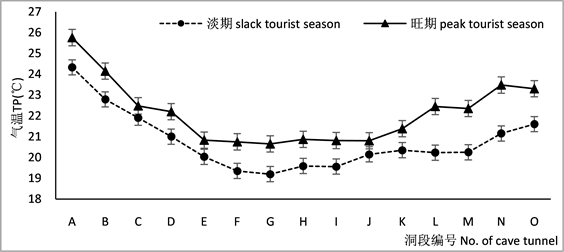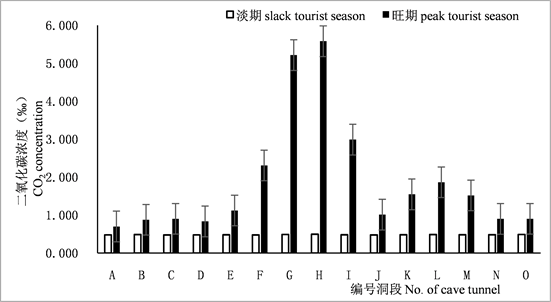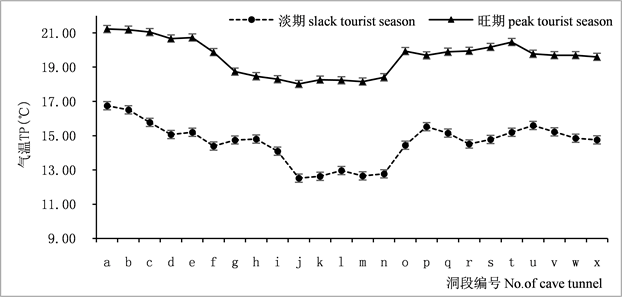1. 引言
岩溶洞穴简称溶洞(Karst cave),是指经过岩溶作用形成的人体能够进入的天然地下空间,也是近年人类热衷于研究并具有区域开发利用价值的自然资源。由于溶洞是相对封闭的自然生态系统,洞内环境较少受到外界气象因子的影响,洞穴生物(尤其是真洞穴动物)的生态生物学特征及其起源演化机制等方面的研究已受到广泛的重视 [1] [2] [3] [4] 。洞穴医疗、洞穴旅游开发也已成为区域经济开发的重要内容 [5] [6] [7] [8] 。
人类的洞穴旅游活动对洞穴动物的生存和繁衍可能产生深远的影响,并可能导致洞内灯光植物(Lampenflora)的滋生,而灯光植物的生长进而会促使洞穴内环境的改变,以致钟乳石变色或崩塌,加速洞穴衰退 [9] [10] 。可是,由于缺乏对溶洞景观吸引力及游客客源的系统评估,有些溶洞被盲目开发后被迫废弃。而被废弃的溶洞与旅游热点溶洞之间主要气象因子及洞穴生物的比较研究是洞穴旅游管理和洞穴资源开发与保护的基础性工作。
为探究溶洞主要气象因子及洞穴生物对于人类洞穴旅游活动的反应,近年笔者对湘西土家族苗族自治州(简称湘西州)境内的多个溶洞进行了调查,选取两个具有代表性的旅游热点洞穴与废弃洞穴开展了气温、湿度、CO2浓度及生物种类的观测、调查和比较,以期为洞穴旅游开发管理及洞穴资源保护相关问题的深入研究提供参考。
2. 研究方法
2.1. 调查区域自然概况与样洞选择
湘西州(109˚10'~110˚22.5'E,27˚44.5'~29˚38'N)位于武陵山脉东部,属云贵高原向东部丘陵平原的过渡区域,地处我国华中、华南、西南三个动物地理区的交汇地带及湘鄂渝黔四省边区,下辖7县1市,总面积约1.5 × 104 km2。由于受酉水、猛洞河、武水、沅水、辰水等河流的冲蚀,境内被切割成众多的盆地、台地、高峰、沟谷及陡坡。州域属中亚热带季风湿润性气候,具有明显的大陆性气候特征,一月平均气温约为4.4℃,无霜期271~294 d,年均降雨量1200~1600 mm,但受海拔、地形、坡向等因素的影响,州境内的小气候存在明显的垂直和水平分布格局,气温、降水、日照、无霜期等气候因子的小区域差异显著。州域内碳酸盐广布,岩溶地貌发育良好,溶洞较多 [11] 。
根据项目组前期调查所获得的信息 [12] ,选取洞道结构层次及复杂度较为相似、海拔接近且周围植被景观差异性较小的溶洞作为样洞(表1),其中堂乐洞是旅游废弃洞穴,奇梁洞是旅游热点洞穴,对比研究旅游活动对其主要气象因子及洞穴生物的影响。
2.2. 研究方法
采用智能手机的GPS功能记录溶洞的地理坐标及海拔,利用UT391+激光测距仪(量程60 m,精确度±1.5 mm)测量洞道的深度,将便携式气象站(Kestrel 4500 Pocket Weather Tracker)(精确度:湿度±3%,温度±1℃)和手持农业环境监测仪(THHY-5-A) (CO2精确度:±0.07‰)悬挂在大背包外随人身所到之处自动记录洞穴中的气温、湿度及CO2浓度等主要气象因子,以反映洞内气象因子的连续动态变化情况。将便携式气象站的数据自动记录时间间隔设定为30或60秒。手持农业环境监测仪的数据自动记录时间间隔虽最短只能设置为5分钟,但由于观察记录洞道周围动、植物分布情况需要花费较多的时间,人行进的速度较慢,因此仪器每5分钟自动记录一次气象因子数据也能够反映各洞道内主要气象因子的基本情况。
沿洞道调查时,通常3~5人相隔一定的距离缓慢行进,头戴或手持强光灯全面扫视在保证安全的情况下人身能够进入或涉水能够通过并且肉眼可达的洞内各处,观察记录并拍摄所见到的生物种类、数量及其微生境。对于旅游洞穴,则沿着旅游通道行进,同时用强光灯全面扫视所到之处及其附近地面和岩壁上可能隐藏的动物,特别注意观察、记录、拍摄每盏灯周围可能分布的灯光植物,并用小刀刮取或小心拔出一些样株放入采集袋中,编号,带回室内,依据有关的工具书及参考文献 [13] [14] [15] [16] [17] ,必要时请求相关的专家帮助进行物种鉴定。

Table 1. Basic information of the two sample Karstic caves
表1. 两个样洞的基本信息
注:F—开发后被废弃的溶洞;L—旅游热点溶洞;+—洞道短,结构简单;++—洞道较长,结构较为复杂;+++—洞道较长且分支分层。(Notes: F—abandoned Karst cave after unconscionable development; L—hotspot Karst cave for tourism; +—short cave tunnel with simple structure; ++—little long cave tunnel with slightly complex structure; +++—longer cave tunnel with multilayered and branching structure)
无论是旅游洞穴还是废弃洞穴,每天进洞旅游观光或游玩的人数都有所不同,往往差异还很大,为简化分析,我们根据实际观察并结合洞穴管理人员或附近村民所反映的情况将调查时间划分为旅游淡期和旅游旺期:对于奇梁洞,淡期是指一天之内进洞旅游的人数仅为数百人,旺期则多达数千人,分批统一进出洞穴;对于堂乐洞,淡期意味着一天之内进洞游玩的人数很少,通常只有几人或十几人,而旺期(主要是节假日)进洞游玩的人数虽较多,通常也不过数十人,并且大多三五成群自由进出洞穴。
根据主要景点的位置将奇梁洞和堂乐洞的洞道划分为若干洞段,然后分段、分期统计分析仪器自动记录的气温、湿度及CO2浓度。按行进路线将奇梁洞的主要洞段划分如下:A-洞口→雨洗新荷、B-雨洗新荷→白岭大海沟、C-白岭大海沟→海底世界、D-石花→苗王议事大厅、E-十里画廊→黄果树瀑布、F-黄果树瀑布→黄龙戏水、G-倒挂石林→林海雪原、H-林海雪原→西湖、I-西湖→白象迎宾、J-人工隧道→天堂景区、K-天堂景区→御花园、L-御花园→白塔群、M-白塔群→天堂景区、N-白岭大海沟→海底世界、O-雨洗新荷→洞口,其中E-I为“十里画廊大景区”的洞段。同样,按行进路线将堂乐洞的主要洞段划分如下:a-洞口→迎客厅、b-迎客厅→龙宫、c-龙宫→雀儿寨、d-雀儿寨→三岔口、e-三岔口→舞厅、f-舞厅→观景台、g-观景台→南瓜洞、h-南瓜洞→观景台、i-观景台→三岔口、j-三岔口→一线天、k-一线天→石壁长廊、l-石壁长廊→南天门、m-南天门→司令部、n-司令部→岔路口、o-岔路口→洞穴最深处、p-洞穴最深处→岔路口、q-岔路口→盲洞、r-盲洞→岔路口、s-岔路口→司令部、t-司令部→南天门、u-南天门→一线天、v-—线天→雀儿寨、w-雀儿寨→迎客厅、x-迎客厅→洞口。
采用Excel、Spss22.0软件进行数据分析,利用其中的单因素ANOVA对两个溶洞的气象数据进行方差分析。
3. 结果与分析
3.1. 旅游淡、旺期两个溶洞内气温、湿度及CO2浓度的动态变化
无论是在旅游淡期还是旺期,奇梁洞和堂乐洞洞道内的气温(TP)、湿度(RH)及CO2浓度都存在差异,处于动态(图1~6),但也具有一些共同的特征。在旅游淡、旺期,两个溶洞的最高气温均在洞口附近,随着洞道的深入,气温逐渐下降,奇梁洞淡、旺期的最低气温都在倒挂石林-林海雪原(G)洞段(图1),堂乐洞则都在三岔口-一线天(j)洞段(图4)。相反,两个溶洞中空气的最低湿度都在洞口附近,随着洞道的深入湿度逐渐增大,在淡、旺期时,奇梁洞分别在十里画廊-黄果树瀑布(E)和御花园-白塔群(L)洞段达到最大值(图2),堂乐洞则分别在岔路口-司令部(s)和司令部-南天门(t)洞段达到最大值(图5)。奇梁洞中CO2浓度

Figure 1. Changes of air temperature in the different tunnel sections of Qiliang cave in slack and peak tourist season
图1. 在旅游淡、旺期奇梁洞不同洞段气温的变化

Figure 2. Changes of air relative humidity in the different tunnel sections of Qiliang cave in slack and peak tourist season
图2. 在旅游淡、旺期奇梁洞不同洞段空气相对湿度的变化

Figure 3. Changes of air CO2 content in the different tunnel sections of Qiliang cave in slack and peak tourist season
图3. 在旅游淡、旺期奇梁洞不同洞段空气中CO2含量的变化

Figure 4. Changes of air relative humidity in the different tunnel sections of Tangle cave in slack and peak tourist season
图4. 在旅游淡、旺期堂乐洞不同洞段相对湿度的变化

Figure 5. Changes of air temperature in the different tunnel sections of Tangle cave in slack and peak tourist season
图5. 在旅游淡、旺期堂乐洞不同洞段空气气温的变化

Figure 6. Changes of air CO2 concentration in the different tunnel sections of Tangle cave in slack and peak tourist season
图6. 在旅游淡、旺期堂乐洞不同洞段空气中CO2浓度的变化
的峰值在淡、旺期均于十里画廊大景区的林海雪原-西湖(H)洞段呈现,最小值则在洞口段(图3),而堂乐洞均在洞穴最深处-岔路口(p)洞段达到峰值,最小值则分别在洞口-迎客厅(a)和迎客厅-洞口(x)洞段呈现(图6)。总体而言,奇梁洞十里画廊大景区(E-I)的气温、湿度变化较为平缓,但CO2浓度的变化特别剧烈(图1~3);两个溶洞的洞口段由于受到外界气象因子的影响,出洞和入洞时洞口段的温、湿度存在明显的差异(P < 0.05),出洞时的气温低于进洞时的气温,湿度则相反。
3.2. 两个溶洞之间温湿度及CO2浓度的比较
奇梁洞和堂乐洞洞道内的气温、湿度及CO2浓度在旅游淡、旺期的(变化)范围、(平)均值及其相互之间的差异性比较见表2。奇梁洞的气温、CO2浓度,以及堂乐洞的气温、湿度和CO2浓度在淡、旺期都存在显著性差异,而奇梁洞的湿度不存在显著性差异。两个溶洞之间的气温、湿度和CO2浓度在旺期均存在显著性差异,但在淡期湿度不存在显著性差异。

Table 2. Comparison of air temperature, relative humidity, CO2 concentration between Qiliang and Tangle caves in slack and peak tourist season
表2. 奇梁洞和堂乐洞在淡、旺期气温、湿度及CO2浓度的比较
3.3. 在两个样洞中所观察到的主要生物类群
在这两个溶洞中,总共观察记录到动物18科25种,灯光植物3科7种,其中洞栖性蝙蝠占优势,共计4科11种(表3)。在奇梁洞内,记录到动物9科9种,其中蝙蝠4科4种,即大蹄蝠、皮氏菊头蝠、鼠耳蝠和印度假吸血蝠;其他动物还有蜘蛛、斑灶马、菌蚊、尺蛾和烟管螺。在堂乐洞内,观察到动物17科24种,其中蝙蝠3科10种,即中华菊头蝠、菲菊头蝠、皮氏菊头蝠、大菊头蝠、贵州菊头蝠、大耳菊头蝠、大蹄蝠、西南鼠耳蝠等,还见到小泡巨鼠、雷氏大疣蛛、盲蛛、马陆、蚰蜒及紫啸鸫等更多的动物。从奇梁洞15个采样点采集的灯光植物中已鉴定出7种蕨类植物,另2种苔藓还有待鉴定。蕨类中包括黑足鳞毛蕨、凤尾蕨、岩凤尾蕨,以及贯众属3种和卷柏属1种。在堂乐洞中数量较多的是中华菊头蝠、斑灶马和尺蛾,而奇梁洞中的灯光植物以贯众占优势,各种动物的数量则很少。
4. 讨论
4.1. 溶洞中主要气象因子的时空异质性
一般认为,溶洞处于封闭或半封闭状态,洞道中的气温、湿度等气象因子处于稳定或恒定状态,因此通常仅在洞道的某处或个别位点测量有关的气象数据。本文发现,溶洞内部的气象因子存在明显的时空异质性,不仅存在洞间差异,在同一洞穴中的不同洞段及不同时段都存在差异,既具有日变化也存在季节性变化,还受到人为因素的影响,甚至还具有短期的非周期性变化 [18] ,因此今后在洞穴气象因子测量及溶洞环境质量评价时对于洞穴环境因子的时空异质性应予以充分的重视。
洞穴气象或环境因子异质性产生的原因是多方面的,但洞内外空气流动是主要原因,洞内空气与洞外空气之间通过洞口进行对流、传导、辐射等热量交换,从而影响洞内气温、湿度等气象因子的分布变化 [19] 。另一方面,由于人类经济活动的加剧,人类对于洞穴环境因子的影响也日益加剧。在自然因素和人为因素的双重作用下,不同溶洞呈现不同的时空异质性。就堂乐洞而言,由于被旅游业主所废弃,旅游强度较低,受到的人为影响相对较小,洞内气象因子自我调节能力较强,恢复较快,在旅游淡、旺期气温、湿度及CO2浓度的分布差异较为明显(图4~6、表2)。相反,奇梁洞是旅游热点洞穴,旅游强度较大而稳定,旅客对洞内环境产生持续的影响,致使洞内温湿度的分布相对较为均匀,差异相对较小,并且在通风不良,气流不畅的洞段还积蓄着高浓度的CO2 (图1~3、表2)。

Table 3. Animals and plants observed in the two sample Karst caves
表3. 在奇梁洞和堂乐洞所观察到的动物与植物种类
Continued
注:“+”有发现但数量少;“++”较为常见;“+++”数量较多(Notes: “+” less; “++” common; “+++” more)。
洞口的数目及位置也是影响洞穴环境异质性的重要因素,尤其是位于洞道顶壁的垂直洞口通常还会产生“烟囱效应”,使得洞内外的气压、气流、风速产生明显的季节性变化 [20] ,继而引发洞口附近微环境的季节性差异。
4.2. 溶洞气象因子对人类旅游活动的反应
溶洞在开发之前,洞内小气候(或微气候)与洞外大气候相比相对稳定 [21] 。但在旅游开发利用的过程中,游道、灯光、护栏等洞内旅游设施的建设会使洞穴原生态受到破坏,不仅洞道的原始形态发生变化,游客的体热和呼吸也会影响洞道内的小环境,导致洞内气温、湿度的变化与CO2浓度的升高 [22] [23] 。
对于单洞口的溶洞或虽有多个洞口但支洞内仅有一个进出口的溶洞而言,洞道中CO2的浓度随洞道的深入而升高,通常在空气流动不畅的洞段或洞道的盲端达到最大值,奇梁洞的十里画廊大景区(E-I)洞道低矮(人需低头弯腰才能通过),空气几乎处于静止状态,而该洞段又是进出著名景点——林海雪原的必经之道,因此游客呼出的CO2在此处积蓄,CO2浓度聚然升高,并且游客较多的旺期与较少的淡期相比,存在显著性差异(P < 0.05),在林海雪原-西湖(H)洞段峰值高达5.582‰,超过空气中CO2含量对人体及洞穴环境影响评价指标二级(1‰~3‰)和三级标准(3‰~5‰) [24] 。
堂乐洞的情况明显不同,因已被废弃,其受人类旅游活动的影响相对较小,洞内CO2浓度在淡期总体较低,仅在旺期时在岔路口通往洞穴最深处与盲洞洞段(o-r)达到二级标准。堂乐洞淡、旺期CO2浓度虽也存在明显差异(表2),但与奇梁洞相比,差异较小。
4.3. 洞穴动物分布的不均匀性及对人类旅游活动的反应
洞道中的微环境多种多样,微环境因子具有时空异质性,因此生活在洞穴中的动物也并非均匀分布,斑灶马和尺蛾是洞道中常见的无脊椎动物,多见于洞道的前段,洞的深处较为少见。而马陆、烟管螺等许多无脊椎动物的分布与蝙蝠的粪场密切相关。蝙蝠是溶洞中处于优势地位的脊椎动物类群,但不同的蝙蝠种类栖于不同的洞段,冬眠期间,鼠耳蝠多栖于洞的前段,菊头蝠多见于洞的深处,而夏季繁殖期间大蹄蝠特别强势,多集群悬挂于洞口附近宽阔洞厅的顶壁。最值得注意的是,专一性地吸食蝙蝠血液的洞穴山蛭仅分布于某些湿度较高并相对封闭的特殊洞道的洞壁。
由于长期高强度的人为干扰,栖于奇梁洞中的动物种类及数量都很少,并且主要隐藏在游客难以到达或不易觉察的狭缝间或构造复杂的黑暗岩壁凹窝内。堂乐洞已被废弃多年,游客零星而分散,旅游强度较低,在洞内栖息的动物种类及数量都较多,我们甚至还发现了400多只中华菊头蝠聚集在一起冬眠,以及300多只大蹄蝠聚在一起育幼的场景。
蝙蝠对人类进洞活动特别敏感,尤其在选择冬眠场所的“冬眠前期”和选择育幼场所的“育幼前期”,强烈的人为干扰通常会促使蝙蝠迁出而另寻它洞栖居。而洞栖性蝙蝠的迁居必然影响到洞内其他粪食性无脊椎动物的种群繁衍,以至整个洞穴生态系统的演化。
4.4. 洞穴植物的馈乏与灯光植物的滋生
洞穴植物通常仅分布在洞道的弱光带或门坎带 [25] [26] ,在黑暗的洞道中植物不能持续生长和繁衍,因此生长在溶洞内的植物种类及数量都很少。但随着溶洞旅游的兴起及旅游品味的提升,客流量持续增长,洞内游道及照明设施的建设越趋规模化和现代化,为洞内植物的生长创造了条件,从而导致灯光植物的滋生。奇梁洞游客较多而稳定,洞内灯光设施完善,长期的灯光照射已导致灯光植物的繁衍,而堂乐洞被废弃后尽管洞内温、湿度等微环境因子适合植物的短期生长,但因缺乏持续的光照,植物体发芽或长出后就很快萎缩。
一般认为,灯光植物对洞穴生态系统有负面的影响,应加以防治 [27] 。可是,灯光植物在洞穴生态系统中是否有多方面的作用,对于洞穴动物类群的演化是否也有积极的意义值得深入探讨和研究。
致谢
在植物标本的鉴定过程中,得到本院张代贵老师的悉心指导,本院研究生孙林、李冰在数据处理过程中予以帮助,谨此一并致以诚挚的谢意。
基金项目
国家自然科学基金(31560130)。